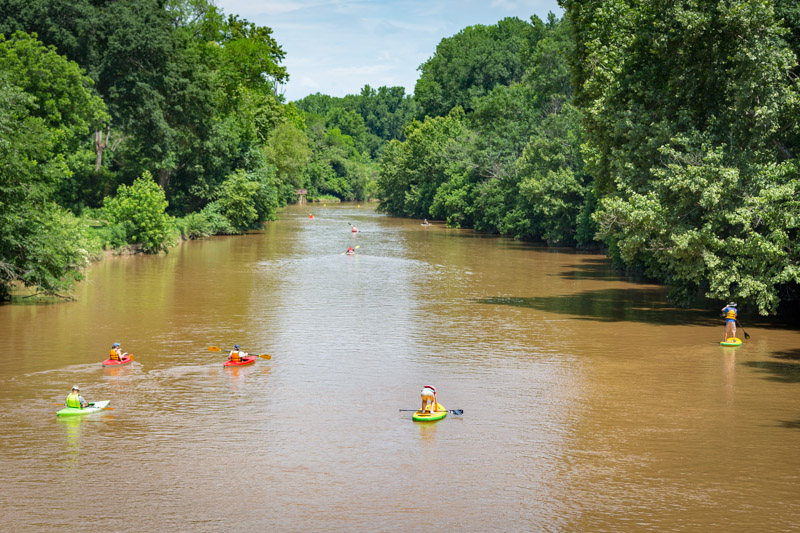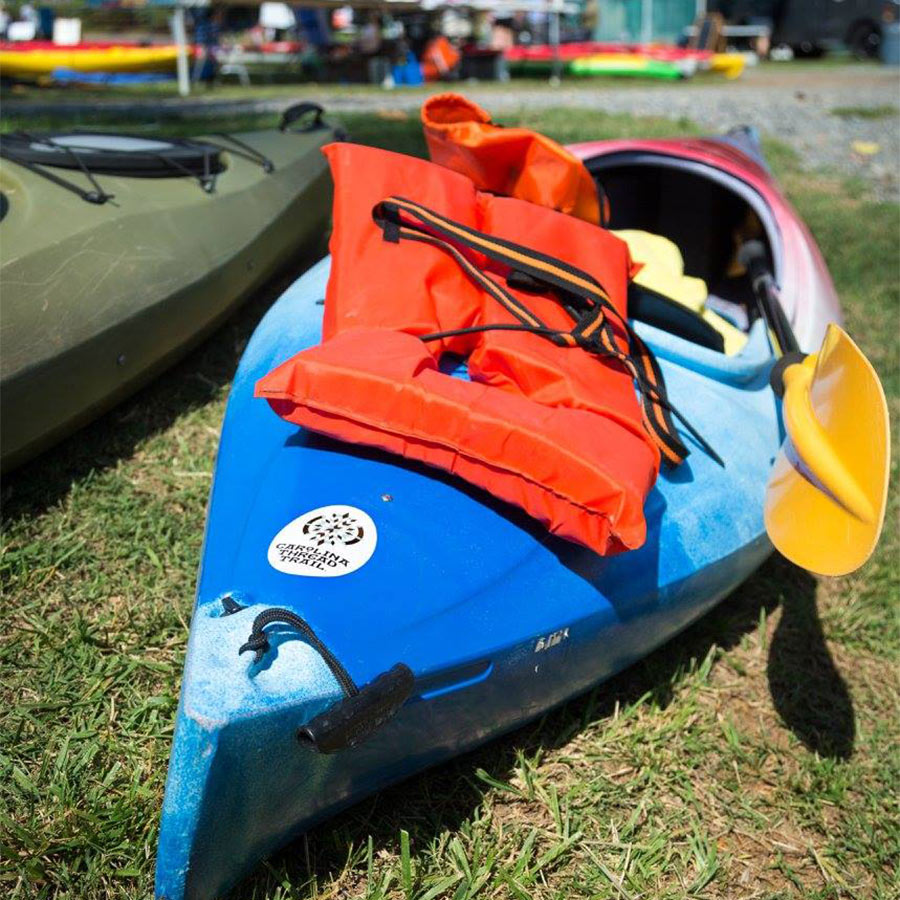What Is the Midland North Carolina Blue Way
65-Mile Rocky River/Pee Dee River Blueways Open River to Recreation
By Anna Gibson
Great Blue Herons glide overhead; a cluster of deer swim soundlessly across the channel; an elusive bald eagle skims the treetops overhead as miles and miles of secluded flatwater paddling unfold down river.
Could this idyllic adventure be just 30 minutes outside Uptown Charlotte? For the first time this spring, the answer is yes with the completion of the Rocky River and Pee Dee River Blueways.
Just over 20 miles due east of Charlotte, the Carolina Thread Trail's newly completed Rocky River and Pee Dee River Blueways traverse a rural, mostly undeveloped 65-mile stretch of river through mixed pine, hardwood and bottomland hardwood forest.
The absence of residential development, docks and motorized boats creates a true wilderness experience for kayakers and canoers. Access at eight public launches stretching from the Pharr Family Preservein Midland, N.C., past the confluence of the Rocky and Pee Dee Rivers to Blewett Falls Lake in Lilesville, N.C., make it possible to plan trips ranging from 4 to 18-plus miles.
The Blueway, created through the efforts and funding of the Thread Trail and a regional partnership of 11 corporate, government and nonprofit organizations, offers something for paddlers of all skill levels. Because of the number of public access points, novices and families can put in for a half-day paddle while more experienced boaters can extend distances for full-day trips.
 Gently sloping riverbanks provide long sight lines through the forested landscape, interrupted only by the occasional farmhouse. White-tailed deer, raccoon, wild turkey and otters can be seen from the water. Raptors such as red-tailed hawks and barred owls, as well as great blue herons, egrets, osprey and native wood ducks live on the river.
Gently sloping riverbanks provide long sight lines through the forested landscape, interrupted only by the occasional farmhouse. White-tailed deer, raccoon, wild turkey and otters can be seen from the water. Raptors such as red-tailed hawks and barred owls, as well as great blue herons, egrets, osprey and native wood ducks live on the river.
The area also lies on the migratory route for a host of Neotropical songbirds like hummingbirds, grosbeaks and buntings. Fishing is generally better on the Pee Dee and the undeveloped tract running through the Pee Dee National Wildlife Refuge affords some of the best birding and wildlife viewing on the river.
The Rocky and Pee Dee Blueways are navigable the majority of the year. At the northernmost launch at Pharr Family Preserve, the river is narrow with class I and II rapids. Progressing downstream, the river gets wider and rockier. Paddling past launches in Oakboro and Norwood, N.C., the Rocky joins the Pee Dee River flowing south out of Lake Tillery.
The Pee Dee grows even wider, with a faster and steadier current that can flow at twice the rate of the Rocky River. Water levels on the Pee Dee are dependent on Tillery dam releases, guaranteeing higher water levels in any season.
"We're planning to have dam release information at our kiosk so people know where to go online to find out that information," says Pee Dee National Wildlife Refuge Manager JD Bricken. "Some people might want to canoe or kayak on release days, which will be a little bit more challenging. We think the average canoer or kayaker will want to go on a non-release day to cruise along at their own pace."
"Blueways were not a focus of the original Carolina Thread Trail master plan," says former Thread Trail Senior Director Andy Kane. "They kept coming up in our conversations with communities and have been well received. They are a well-used amenity and an economic driver, getting people to come to a community, eat lunch, and rent a kayak or take their boat out."
A few hours spent paddling the Rocky River and Pee Dee River Blueways makes it easy to understand why.
Know Before You Go: Weather & Water Conditions
Weather conditions play a pivotal role in the paddling experience and trip safety, and boaters are advised to check weather forecasts for the region before getting on the water. Levels on the Rocky River can fluctuate five feet or more within an hour or two with precipitation upstream of launch sites in Charlotte. A USGS gaging station at Norwood monitors Rocky River water levels and flow rates and should be checked before a trip: www.waterdata.usgs.gov/nwis
The best measurement of paddling conditions is discharge, or stream flow, measured in cubic feet per second (CFS). A measurement of 175 CFS indicates a minimum water level for good paddling, while readings of 250 to 1200 indicate good paddling conditions with faster current, higher water and fewer rapids.
Lake Tillery dam releases create a faster flow and a more challenging paddle on the Pee Dee River section of the Blueway. On nonrelease days, conditions lend themselves to a leisurely paddle more suited to novices and those wanting to explore the river at a slower pace.
Duke Energy has a recreation flow release program with 11 scheduled dam releases of 800-1000 CFS. The scheduled releases occur on Saturdays and are posted on the Duke Energy website. Visit www.duke-energy.com/home, click on "Explore Our Lakes & Recreation" and "Flow Releases." Choose "Yadkin Pee Dee" from the drop-down menu to view the dam release schedule.
As with the Rocky, Pee Dee water levels fluctuate with precipitation upstream, so dam release information should be combined with weather monitoring for a more complete picture of river conditions.
 Take the Trip
Take the Trip
Wildlife resources officials and outfitters who have paddled the Blueways recommend the following trips. Actual paddling time varies depending on weather, water conditions and paddler ability.
Half-day trips (3-4 hours):
- Pharr Family Preserve to the Riverbend Farm in Midland (4.5 miles)
- Pee Dee National Wildlife Refuge to the Red Hill/Hwy. 109 (3.5 miles)
Full-day trips (6-8 hours):
- Riverbend Farm to RROPP/Hwy. 205 in Oakboro (18 miles)
- Plank Road to the Pee Dee National Wildlife Refuge (13 miles)
If you don't own a canoe or kayak, Cabarrus County outfitter Capstone Climbing & Adventure (www.capstoneclimbing.com) offers guided half- and full-day trips for groups of six or more on the Rocky River portion of the Blueway.
To learn more, visit the Carolina Thread Trail's online map: www.carolinathreadtrailmap.org.
schwankeforthemight.blogspot.com
Source: https://www.carolinathreadtrail.org/going-the-distance/
Post a Comment for "What Is the Midland North Carolina Blue Way"